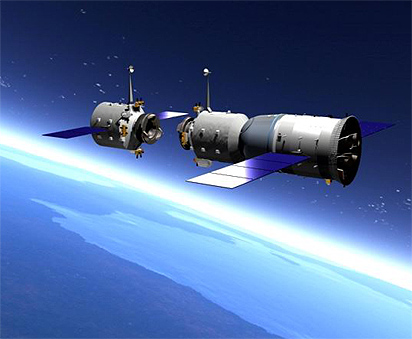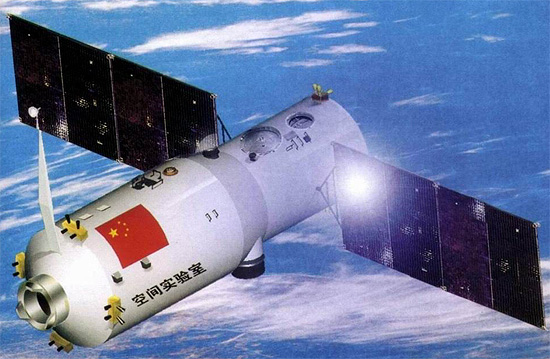| PROJECT 921-II (SPACE WALK, SPACE DOCKING, AND SPACE LAB)
中国航天921-II计划(太空行走、空间对接技术和空间实验室) Date:2016-01-08 Source:internet By:Globalmil Viewed: |

中国宇航员太空行走的想象图
Artist impression of Chinese astronaut taking space walk.
In June 2001, the chief engineer and designer of the Chinese ShenZhou spaceship revealed in a conference held in Beijing that China’s manned spaceflight programme consists of three phases. The first phase would consists of a number of unmanned and manned missions to demonstrate flight of Chinese astronauts in near-Earth orbit and their safe return to earth. In the second phase of the programme, known as Project 921-II, space walk, rendezvous and docking tests will be conducted. This would finally lead to a “Space Laboratory”, which is man-tended on a short-term basis and left fly in automated mode between visits. In the third stage, a 20-tonne permanent space station will be built using China’s next generation CZ-5 space launch vehicle.
在2001年6月,中国神舟太空船总工程师和设计师在北京举行的由三阶段组成的中国有人操纵宇宙飞行计划。第一个阶段会由许多的无人操纵和有人操纵任务所组成,去论证中国宇航员在近-地轨道飞行和他们的安全返回。在计划的第二个阶段中,即是921-II计划,太空行走、交会和对接测试将会被实施。这会最终实施一个“空间实验室”,在逗留期间基于短期有人看守模式和离开自动飞行模式两者之间。在第三阶段中,20吨长期空间站将会被建造,使用中国下一代CZ-5空间运载火箭。

对接二艘太空船的轨道模块(轨道舱)想像图

中国空间实验室想像图
Artist impression of Chinese space lab.
The timeframe for the Project 921-II will be between 2006 and 2015, with the Project 921-III completed in 2020. However, the actual timetable will probably depend on the success of previous missions. The ShenZhou-6 flight scheduled in October 2005 is likely going to be the last flight of Project 921-I. Should this mission go smoothly, the preparations for the Project 921-II will begin in 2006. The first few flights might aim to achieve space walk, and then spaceships operated by astronauts will try to engage, and finally dock the orbital module left from previous flights. By the end of the project, a small space lab possibly by docking the orbital modules of two spaceships will be achieved in the near-Earth orbit.
中国航天921-II计划时间范围将会在2006年和2015年之间,921-III在2020年完成。然而,实际的时间表将会或许仰赖早先的任务成功。在2005年10月被预定的神舟-6飞行很可能是921-I计划的最后一次飞行。这一次任务平稳的,为将在2006年开始的921-II计划准备。最初较少的飞行可能打算实现太空行走,然后宇航员操作太空船将会试着交会、对接轨道舱和从上述飞行离开。计划的最终目的,一个小型空间试验室可能对接二艘太空船的轨道模块(轨道舱)将会在近-地轨道中实现。
上一篇:PROJECT 921-I (MANNED SPACECRAFT) 下一篇:PROJECT 921-III (SPACE STATION)
| TianGong 1 Spaceflight Mission
中国天宫(TianGong) 1航天任务 |
| As the first step, China will launch TianGong 1, also known as “target spacecraft”... [2020-12-08] |
| CHANG'E MOON EXPLORATION PROGRAMME
中国航天月球探险计划 |
| The Chinese government first announced that it was planning to carry out moon exploration and preliminary deep space research in its White Paper on China’s Space Activities published on 11 November 2000.... [2016-01-08] |
| SHENZHOU-1/2/3/4 UNMANNED SPACEFLIGHT MISSION
中国“神舟”-1/2/3/4无人操纵航天飞行任务 |
| Between November 1999 and December 2002, China launched four unmanned experimental spaceships to test the launch vehicle, spaceship, and life support systems onboard.... [2016-01-08] |
| PROJECT 921-III (SPACE STATION)
中国航天921-III计划(空间站) |
| In the third stage of the Chinese manned spaceflight programme, which is known as Project 921-III, China is going to build a permanent space station where astronauts can live for a long period (few months) and conduct various scientific expe... [2016-01-08] |
